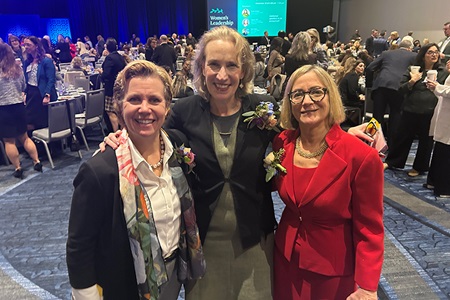Telehealth May Help Young Adults with Type 1 Diabetes Self-Manage Their Health Better
Joslin Experts' Pilot Study Shows Hybrid Care Leads to Better Outcomes for Some With T1D, But Not for All Demographics
BOSTON – For most young people, leaving home and living independently for the first time means suddenly having to manage their own health, from scheduling regular doctor appointments to preparing healthy meals. For young adults with type 1 diabetes (T1D) who must manage their blood sugar levels 24/7 on their own, the stakes are especially high. Evidence suggests young adults with T1D with suboptimal glycemic control are at high risk of hospitalization and long-term complications.
To address many of the challenges to diabetes management faced by young adults with T1D, researchers at Joslin Diabetes Center developed a program that leverages telehealth and provides support from dedicated case managers who serve as liaisons between patients and their care teams. In a paper published in Endocrine Practice, the researchers report that their pilot program, known as Leveraging Intensive Follow-Up Treatment in Young Adults (LIFT-YA) was associated with improved glycemic control and an increase in adoption of continuous glucose monitors (CGM)—two keys to improved outcomes for young adults with diabetes.
“Young adults with T1D encounter numerous challenges to more independent diabetes self-management, including increased responsibilities, work and school demands and financial challenges,” said senior author Elena Toschi, MD, Director of the Young Adult Program at Joslin. “As evidenced through the COVID-19 pandemic, adoption of telemedicine for the management of T1D was generally well received and has been shown to increase clinic attendance and patient satisfaction. The use of telehealth has the potential to provide more frequent visits in young adults with T1D while saving commuting time and related costs.”
Toschi and colleagues designed the LIFT-YA program to identify the clinical and social barriers that interfere with young adults’ ability to manage their T1D. They also designed it to evaluate the use of telehealth to facilitate attendance and collect patients’ health data and assess the impact of case managers in young adults’ care.
The team invited 57 eligible young adults age 18 to 30 years old with T1D who had established adult care at Joslin to participate in the six-month, seven-visit program. Of the 24 people who chose to enroll in the program, 13 “completers” attended more than half of the visits (at least four out of seven). The remaining 11 young adults attended fewer than four.
Visits were focused on identifying challenges to diabetes care and devising actionable plans to address them. The most frequently cited challenges were scheduling conflicts with work and school, navigating the approval processes for diabetes technology supplies such as CGM and incomplete understanding of the effects of meal macronutrients.
The high cost of insulin, high deductibles and co-pays, the lack of paid time off, however, were also frequently cited challenges that the medical staff were not able to directly address.
“Most of the young adults who weren’t able to participate at all reported time and/or cost of copayments as the main reason for declining,” Toschi added. “These findings reaffirm the burden of socioeconomic determinants of health that are associated with suboptimal glycemic control. Any program focused on young adults should aim to increase schedule flexibility and/or frequency of visits and/or reduce the cost to enable equitable access across all demographic groups.”
At the end of the pilot study, the researchers compared outcomes of those able to complete the program and those able to attend fewer than half the meetings, as well as the 33 people who did not participate. As expected, the “completers” had a significantly higher number of total visits than the other two groups; no difference in the number of visits was observed between those who attended fewer than four appointments and the group that was unable to participate at all.
Similarly, the number of CGM users increased dramatically by 70 percent among the completers but remained unchanged in the other two groups. Likewise, the completers saw significant reduction in their hbA1c levels, a measure of blood sugar, within their group. Notably, the low levels of CGM users in the other groups made it difficult to compare the groups.
“We believe the efforts of the case managers to overcome operational hurdles and other clinical challenges by coordinating effective communication between participants and the multidisciplinary care team were part of the reason we saw these positive outcomes,” Toschi said. “Leveraging frequent telehealth-based visits and the anchoring role of the case managers provided actionable solutions for at least some of the self-reported barriers to diabetes care in young adults with T1D.”
Co-authors included co-first authors Giulio R. Romero, MD, and Madeline Bennetti, BS, as well as Jennie Votta, NP, Chelsey Gibson, RN, CDCES, and Sarah Gatti, LICSW, of Joslin Diabetes Center.
This work was funded by the Steven M. and Joyce E. Tadler Charitable Trust’s support of the Joslin Young Adult Program. None of the authors declare having any conflicts of interest.
About Joslin Diabetes Center
Joslin Diabetes Center is world-renowned for its deep expertise in diabetes treatment and research. Part of Beth Israel Lahey Health, Joslin is dedicated to finding a cure for diabetes and ensuring that people with diabetes live long, healthy lives. We develop and disseminate innovative patient therapies and scientific discoveries throughout the world. Joslin is affiliated with Harvard Medical School and one of only 18 NIH-designated Diabetes Research Centers in the United States.



